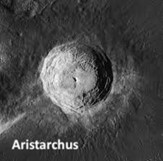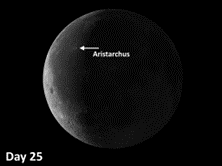The week of March 4-10 takes us from Day 24 to Day 1. This week we will highlight the moon crater Aristarchus, viewable on Tuesday morning an hour before sunrise.

 Aristarchus: [NW/G5; L=47°W] The moon crater Aristarchus is the brightest spot on the Moon. It is so bright that Sir William Herschel1 mistook it for an erupting volcano, and its glow can even be seen coming through on the dark side of the Moon when it is illuminated only by earthshine. While you’re at it, see if you can spot segments of the Tycho ray system which are also visible under earthshine.
Aristarchus: [NW/G5; L=47°W] The moon crater Aristarchus is the brightest spot on the Moon. It is so bright that Sir William Herschel1 mistook it for an erupting volcano, and its glow can even be seen coming through on the dark side of the Moon when it is illuminated only by earthshine. While you’re at it, see if you can spot segments of the Tycho ray system which are also visible under earthshine.
OF ADDITIONAL INTEREST IN SPACE
On Thursday, Mars will be 3.5° north of the Moon and on Friday, Venus is 3° north of the Moon.
Daylight Savings begins on Sunday.
1 18th c. English astronomer who discovered Uranus.
It is highly recommended that you get a copy of Sky and Telescope’s Field Map of the Moon, the very finest Moon map available for use at the telescope. It is available for $10.95 at www.skyandtelescope.com and on Amazon. All features mentioned in this blog will be keyed to the grid on the Field Map and will look like this: Plato: [NW/D9]
Credits:
Courtesy of Gray Photography of Corpus Christi, Texas
Lunar photos: NASA / USGS / BMDO / LROC / ASU / DLR / LOLA / Moon Globe. Used by permission
- Rupes Cauchy: A Best Known Fault on the Moon - July 22, 2024
- Moon Crater Schickard – Crater Floor has Stripes - July 15, 2024
- Moon Craters Langrenus and Vandelinus - July 8, 2024